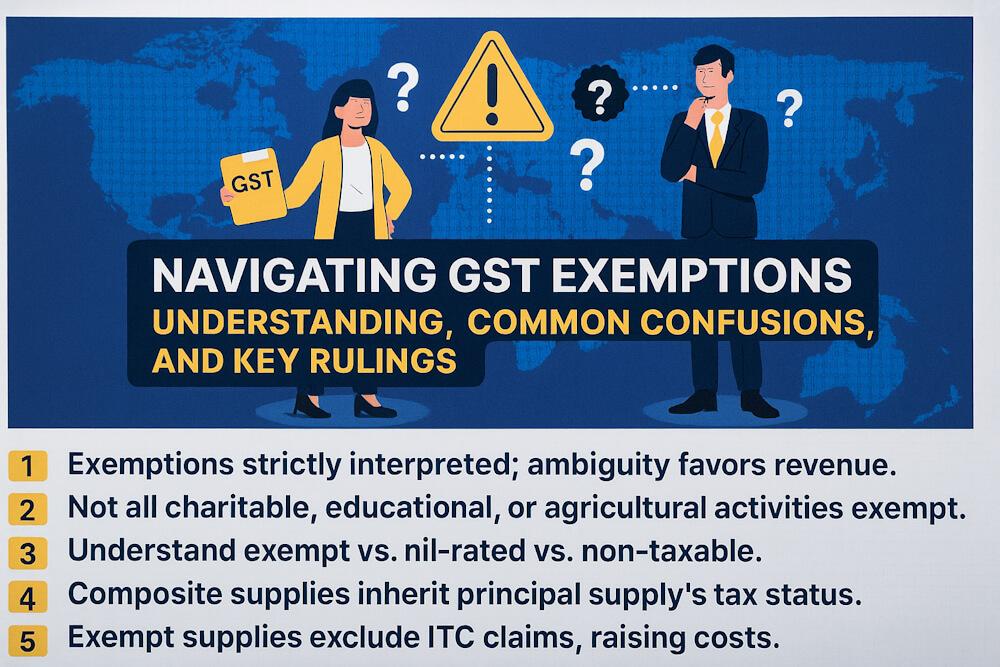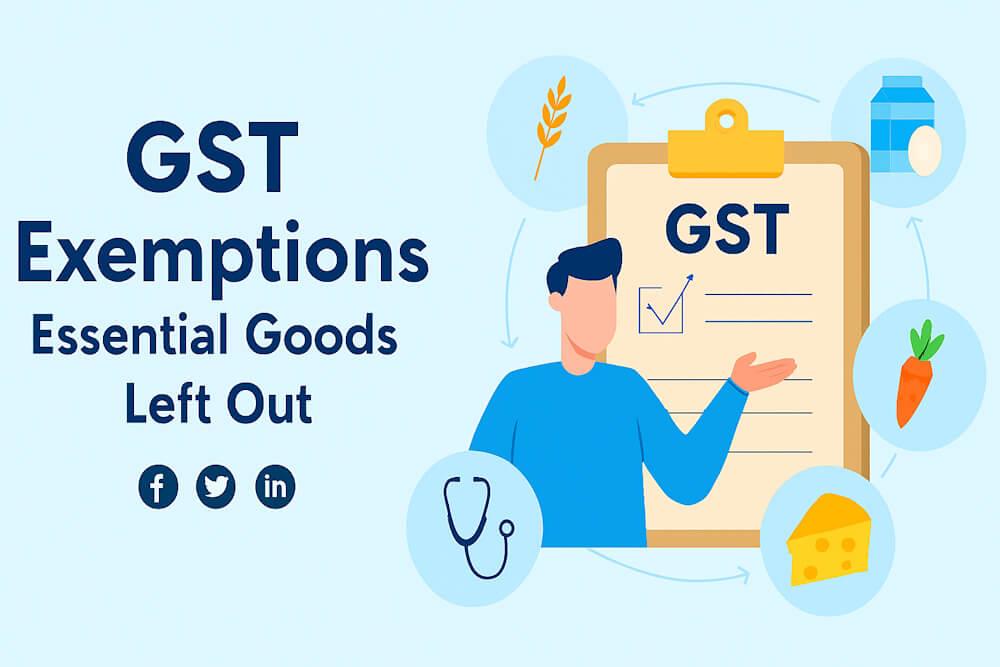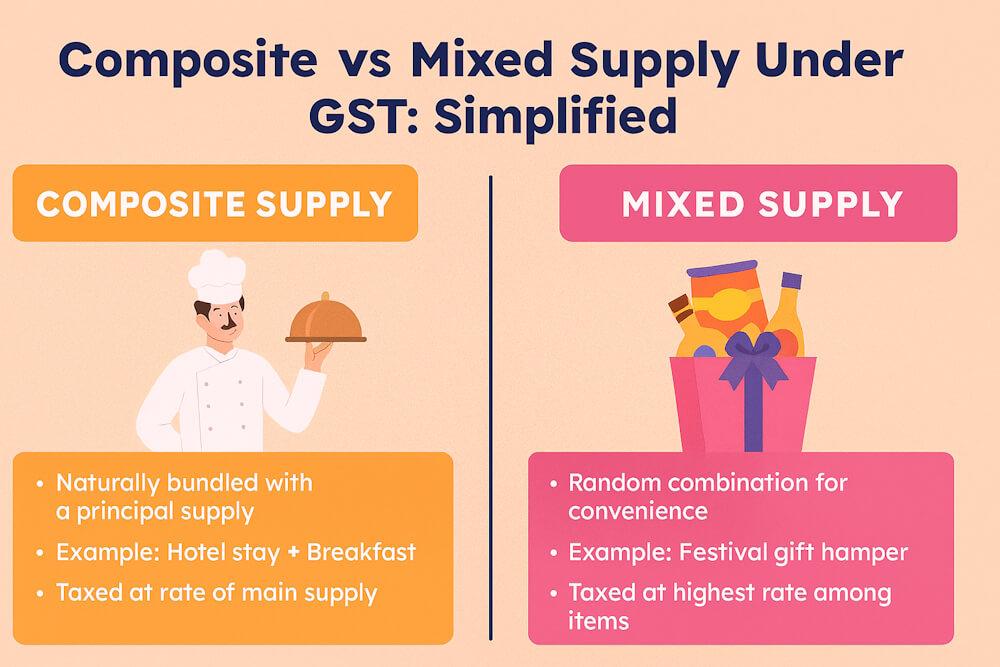The concept of exemptions under GST seems straightforward on paper — certain goods or services are not taxed. But in practice, exemptions are among the most misunderstood areas of GST law.
Businesses, professionals, and even tax officers often interpret exemption notifications differently, leading to confusion, disputes, and litigations.
To clarify these issues, several Advance Rulings (AAR) and High Court decisions have elaborated on what counts as exempt, what doesn’t, and how exemptions must be interpreted.
Let’s break down the real-world implications, common confusions, and important case rulings that every taxpayer and professional should know.
1. The Principle Behind GST Exemptions
The GST Council exempts certain goods and services for reasons like:
- Public welfare and social interest (education, healthcare, agriculture).
- Administrative convenience (small transactions, unorganized sectors).
- Avoiding double taxation (exported goods/services).
However, exemptions are to be strictly interpreted — meaning, if an activity does not clearly fall within an exemption notification, it cannot be claimed by analogy or broad interpretation.
2. Key Legal Principle – Strict Interpretation
The courts have consistently held that tax exemptions must be interpreted strictly, while tax liabilities may be interpreted liberally in favor of the taxpayer.
“Case Law: Dilip Kumar & Company v. Commissioner of Customs (2018) 9 SCC 1 Held: In case of ambiguity in exemption notification, benefit goes to the revenue, not the taxpayer.”
This means if there’s any doubt about whether a supply qualifies for exemption, the taxpayer cannot assume exemption unless it’s explicitly covered under the notification.
3. Common Confusion 1 – “Exempt Supply” vs. “Nil-Rated” vs. “Non-Taxable”
Many taxpayers confuse these three terms, though they mean different things under GST:
| Term | Meaning | Example |
| Exempt Supply | Specifically exempted via notification under Section 11. | Education up to higher secondary. |
| Nil-Rated Supply | Tax rate is 0% under GST rate schedule. | Salt, fresh milk, curd. |
| Non-Taxable Supply | Outside GST scope by definition. | Alcohol for human consumption, petroleum products (till notified). |
“Implication: Exempt and nil-rated supplies are both part of “non-taxable outward supplies”, but they differ in how they’re notified and affect ITC eligibility.”
4. Common Confusion 2 – Exempt vs. Out-of-Scope Transactions
Sometimes activities are neither taxable nor exempt, simply because they are not a “supply” under Section 7.
Example:
A salary paid to employees is not a supply of service — it’s an employer-employee relationship, hence outside the GST scope (not exempted, just non-taxable).
Similarly, interest on deposits, judicial functions, and sovereign activities by the government are non-supplies, not exempt services.
5. Common Confusion 3 – “Composite Supply” vs. “Mixed Supply” and Its Effect on Exemption
Understanding how exemptions apply to bundled services is crucial.
- Composite Supply: Naturally bundled (principal + ancillary). The principal supply decides taxability.
- Mixed Supply: Unrelated goods/services offered together for a single price — taxed at highest rate applicable to any item.
Example (ABC Hospital Case):
A hospital charges one amount for room rent, treatment, and medicines.
👉 Composite supply, with principal supply = health care (exempt).
But a medical shop inside the hospital selling medicines separately → taxable.
6. Common Confusion 4 – Charitable vs. Commercial Activities
Charitable trusts often struggle to determine whether their activities are exempt.
Under Entry 1 of Notification No. 12/2017, only activities that are “charitable in nature” and listed in the notification qualify.
Exempt Activities:
- Public health advancement (medical relief).
- Education to underprivileged.
- Preservation of environment.
Not Exempt:
- Running private hospitals for profit.
- Coaching or commercial hostels.
- Renting property for income.
Case Law: Shri Sai Sansthan Trust (AAR Maharashtra, 2021) – Running commercial accommodation for pilgrims was not exempt, as it wasn’t purely charitable.
7. Common Confusion 5 – Agriculture: When Processing Crosses the Line
Agriculture exemptions apply only up to the primary market stage. Once processing changes the essential nature of produce, it becomes taxable.
Example:
- Paddy → Rice (milling) – taxable
- Raw turmeric → powdered turmeric – taxable
- Grading, sorting, or drying – exempt
Case Law: Nashik Onion Traders’ Association (AAR Maharashtra, 2022) – Sorting and packing onions for APMC sale exempt; processing onions into dehydrated flakes taxable.
8. Common Confusion 6 – Educational Services
Institutions often assume all education is exempt, but only recognized curriculum-based education qualifies.
Example:
- CBSE school or ITI course recognized by NCVT → exempt.
- Private coaching for IIT-JEE or NEET → taxable (commercial training).
Case Law: Great Lakes Institute of Management v. UOI (2020) – PGDM not recognized by UGC or AICTE → taxable as commercial education.
9. Common Confusion 7 – Health Care and Room Rent GST
Hospitals are exempt, but certain services may attract GST.
Example:
Room rent exceeding ₹5,000/day (except ICU) → 5% GST on excess portion. Ambulance services → exempt. Cosmetic surgery (for beautification) → taxable.
Case Law: AAR Karnataka – Rajashree Multispeciality Hospital (2023) – Clarified that GST applies only on the rent exceeding ₹5,000, not on the entire room charge.
10. Common Confusion 8 – Export of Services vs. Exempt Supply
Exports are zero-rated, not exempt. That means no tax is charged, but ITC is allowed (and even refundable).
Exempt supplies, on the other hand, disqualify ITC.
| Type | Tax Charged | ITC Allowed? | Refund? |
| Exempt supply | No | ❌ No | ❌ No |
| Export (zero-rated) | No | ✅ Yes | ✅ Yes |
Case Law: ABB India Ltd. (AAR Karnataka, 2018) – Exported consultancy service to foreign client → zero-rated, not exempt.
11. Common Confusion 9 – Reverse Charge & Exempt Supplies
Even if a service is exempt in the supplier’s hands, it may still attract GST under Reverse Charge Mechanism (RCM) for certain recipients.
Example:
A GTA (Goods Transport Agency) providing transport of agricultural produce → exempt. But transport of manufactured goods → taxable under RCM.
Case Law: M/s XYZ Traders (AAR Gujarat, 2020) – Confirmed that recipient (registered dealer) must pay GST on inward GTA service if it’s not specifically exempt.
12. Confusion Around “Pure Services” to Government
Entry 3 of Notification No. 12/2017 exempts “pure services” provided to government, but taxpayers often misapply it.
Exempt:
- Municipal waste collection, water supply, public sanitation.
Not Exempt:
- Construction or maintenance of commercial buildings.
Case Law: Tata Projects Ltd. (AAR Andhra Pradesh, 2019) – Construction of police quarters = works contract, not pure service → taxable.
13. Advance Ruling Highlights on Exemptions
| Case | Issue | Ruling |
| M/s Mother Dairy (AAR Delhi, 2020) | Packaging and branding of milk | Exempt, since milk remains unbranded essential good |
| M/s Medivision Diagnostics (AAR Kerala, 2021) | Diagnostic services | Exempt as part of healthcare |
| M/s Indo Farm Equipments (AAR Punjab, 2022) | Sale of tractors | Taxable, not agricultural produce |
| M/s Jaipur Development Authority (AAR Rajasthan, 2019) | Leasing land for commercial plots | Taxable (not agricultural use) |
| M/s Apollo Hospitals (AAR Tamil Nadu, 2023) | Room rent exceeding ₹5,000 | Partly taxable on excess |
14. ITC Implications – Often Overlooked
Businesses providing exempt supplies cannot claim Input Tax Credit (ITC) on inputs used for such supplies (Section 17(2) CGST Act).
However, if both exempt and taxable services are provided, Rule 42 allows proportionate ITC.
Example:
A charitable hospital runs:
- Free medical wing (exempt).
- Private deluxe rooms (taxable).
It must reverse ITC proportionate to exempt turnover.
15. Practical Tips to Avoid Exemption Errors
- Read Notification No. 12/2017 carefully — every word matters.
- Keep documentation to prove recognition (for schools, vocational institutes, etc.).
- Segregate exempt vs. taxable supplies in accounting records.
- Use composite supply analysis to avoid wrong classification.
- Don’t mix up zero-rated exports with exempt supplies.
- Periodically review Circulars & Advance Rulings issued by CBIC and AARs.
16. Key Takeaways
- GST exemptions are strictly interpreted — ambiguity favors revenue.
- Not all charitable, educational, or agricultural activities are exempt; only those clearly notified qualify.
- Understand the distinction between exempt, nil-rated, and non-taxable.
- Composite supplies inherit the tax status of the principal supply.
- Exempt supplies restrict ITC claims, increasing actual cost.
- Exemptions evolve — taxpayers must track latest notifications and circulars.
17. Conclusion
Exemptions under GST are designed to balance economic fairness with public welfare. Yet, their application in real scenarios requires precision and legal awareness.
From healthcare and education to agriculture and charitable activities, the GST exemption list is long — but its boundaries are firm.
Understanding how exemptions actually work — through case laws, AAR rulings, and CBIC clarifications — helps taxpayers avoid costly mistakes, penalties, and litigation.
As the law matures, clarity continues to grow, but one golden rule remains constant:
“If in doubt, tax it — unless the exemption says otherwise.”


